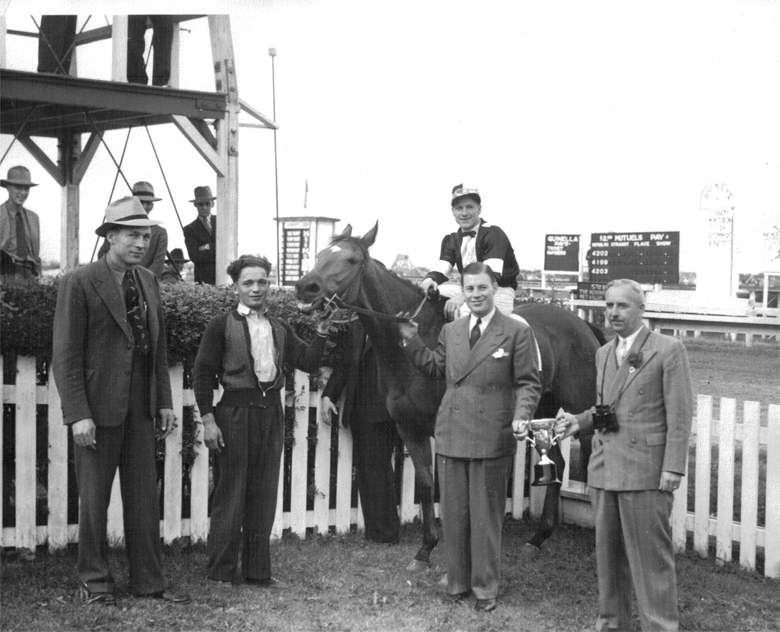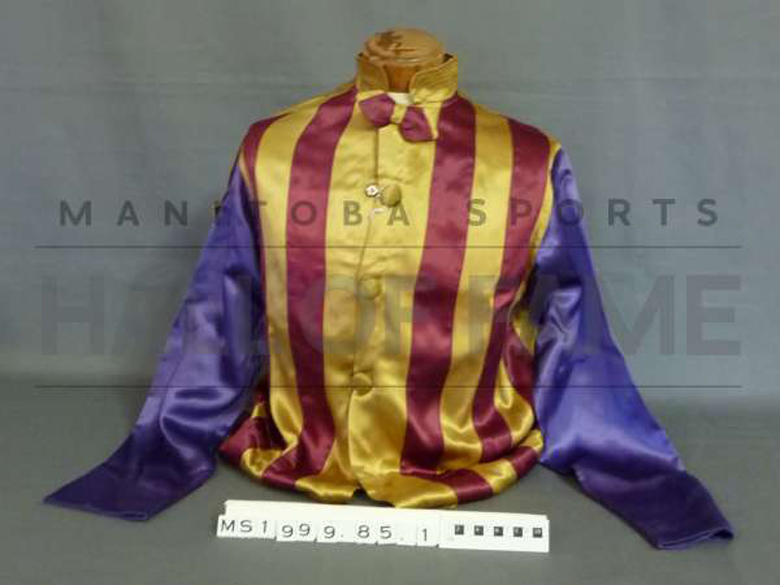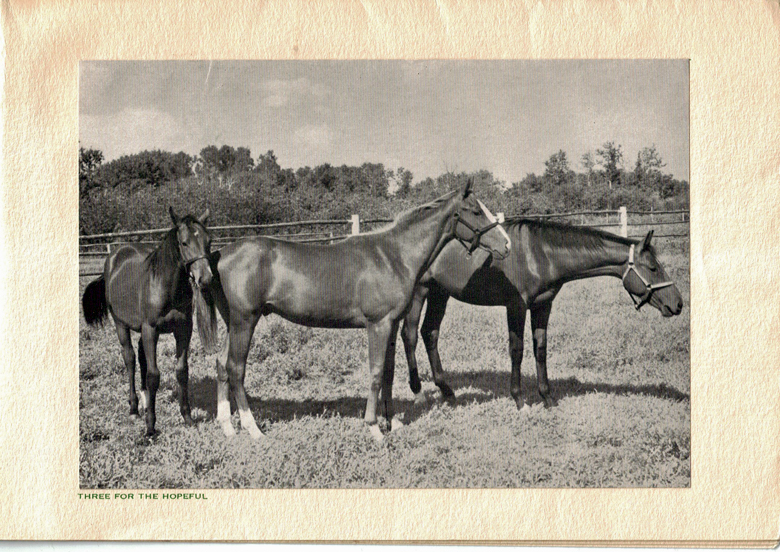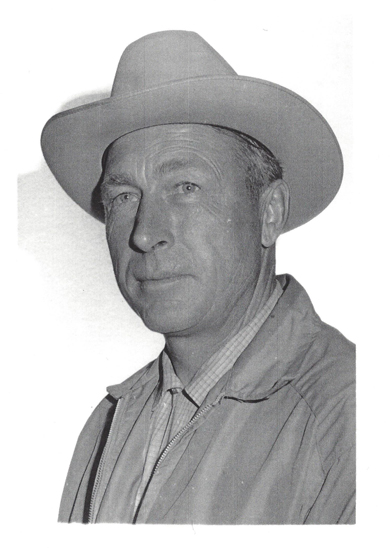
The 37-cent horse, Omar's Gift at Polo Park. "Duke" Campbell on the far left.
by Bob Gates
Donald H. "Duke" Campbell's bio on the Canadian Horse Racing Hall of Fame website says that his chief claim to fame was that he discovered and developed Sandy Hawley into a world class jockey. Well he did that alright, but there was so much more to the man they called "Duke."
From his humble beginnings in southern Alberta in the early 1900s to the second part of his life which saw him successfully train in the big leagues of Ontario, Campbell was a knowledgeable horseman and one of the last true cowboys on the Canadian prairies.
There are conflicting reports as to his place of birth in 1911, some sources said it was High River, others said it was 12 miles east at a place called Frankburg. Still another said it was Whiskey Gap, which is now a ghost town located near the US border. While all of these locales are located in southern Alberta, you gotta love the Whiskey Gap angle - for a cowboy, it's a natural fit.
Campbell was on his first horse at the age of five. In his mid-teens, he was an expert rider with a talent for breaking horses. In the early years he never strayed far from horses. They said Campbell was involved in thoroughbred racing because he liked horses - it was just that simple. He got his start in the business when he was hired by noted horseman, Charlie Leavitt.
As a young man, Campbell made a couple of questionable career choices. He tried barbering and had even had a fling as an amateur boxer, winning the Alberta welterweight title. He learned quickly that if he was going to earn any kind of a living and be happy, it would have to involve horses. He had horses in his blood and he knew they would provide him with a decent living.
In the mid-1930s, veteran starter on the old Prairie Racing Circuit, Jim Donovan took Duke on as an assistant. It was an apprenticeship that would serve Campbell well, and he polished skills that he would use for the rest of his life.
It wasn't long before racing icon, Jim Speers scooped up the pleasant, soft-spoken native of Alberta, who was fast becoming one of the more gifted horsemen in the west.

The jockey silks of Robert James Speers were brought to life by Campbell!
Talk about getting off to a good start on a new job and making a healthy first impression! Campbell was pressed into service when Speers' regular trainer, Jim Dompier fell seriously ill. The result was that several of Speers' horses saw their care fall off to the point where charges Hominy Imp and Peace Token were pretty much rundown and out-of-shape. So Speers had Campbell takeover, and under his care the thoroughbreds rebounded and were ready and raring to race.
The story goes that Hominy and Peace both won at first asking, the former at 87 to 1 and the latter at 65 to 1. It goes without saying that Speers made good money on both horses, but Duke was so preoccupied with getting his boss' business back in good order that he forgot about placing a bet for himself.
Duke conditioned horses for Speers' Whittier Park Stock Farm Stables, as well as other interests. In addition to training, he managed Speers' 15,000-acre, Pine River Ranch located 10 miles south of Carberry. He would work for Speers for more than 20 years until his boss's death in 1955. Speers' passing spelled the end for Campbell's association with the ranch at Pine River which he loved dearly. Duke described Speers as the "grandest man he ever worked for."

Three for the hopeful at Pine River Ranch.
Next, Campbell started training horses for himself. He had spent most of his life around horses and pretty much knew everything about them -- their likes, dislikes, moods and habits, both good and bad. He was as knowledgeable as it came in terms of breaking young horses and schooling them at the gate.
Campbell likened the juveniles to young boys when he said, "Takes a lot of patience though, a young horse is no different to a young boy, they’ll both be alright if they are taught properly at the start. You just can’t force them or push them too hard, they simply get frightened and then you have a real problem on your hands."
Campbell raced horses under his own name at the new Assiniboia Downs using the familiar maroon, gold and blue silks of the Whittier Park Stock Farm. In 1959 he took on the starter duties for the Downs. His ritual would see him work at the Downs during racing season and then it was back home to his ranch at Carberry.
In August 1962 as the curtain fell on season five at the Downs, the news of Campbell's imminent departure to the east broke and everyone knew that the future of the local horse racing scene would be forever changed! Duke owned the starter's job and was a tremendous asset in so many ways to the west end oval.
In the fall of 1962, Campbell moved east to train horses at E.P. Taylor's National Stud Farm in Oshawa. Campbell's departure hit the local scene hard, but it was almost inevitable. He had so much potential and talent, our little corner of the racing world no longer challenged him. Duke needed something more to sink his teeth into and the move east was a great opportunity. He would go on to work for wealthy owners in Ontario including E. P Taylor, Jean-Louis Levesque, Art Stollery and Tom Hays.
Duke never forgot his roots and returned at hunting season to join his buddies, Dr. Norm Anderson, Nick Cizik and brothers, Buster and Harry Jeffrey.
Donald H. Campbell was inducted into the Canadian Horse Racing Hall of Fame in 1984. In March 2000, Campbell passed away at his home in Newmarket Ontario. He was 88.

Donald H. "Duke" Campbell
Who knew?
- Assiniboia Downs' trainer and Carberry native, Murray Duncan said that he got his first saddle from Campbell. And remember Scotty Kennedy's Omar's Gift, the 37-cent horse? Yes, the one that won the 13th running of the Winnipeg Futurity in 1942. His trainer? Duke Campbell!
Wonder what happened to Campbell's pride and joy, the Pine River Ranch? Well it changed hands several times and with each new owner there were changes in how the property was used, - to the point where Campbell wouldn't likely recognize the place.
Gone are the horses and cattle from the days of Robert James Speers. They were replaced first by turkeys in the 1960s and now by a herd of buffalo. What would Duke have to say about turkeys and buffalo taking over what was once a proud horse ranch?
Maybe eastern Canada might see Duke's discovery of Sandy Hawley as his chief claim to fame, but out here in the west, he was a great deal more. Quite possibly, one of the last true cowboys in Western Canada, and as the late A. E. Bert Blake once said...
"One of the greatest horsemen to walk the prairies."


Bob I have CC Ride and other horses at asd Working near Vancouver and met a nice gentleman named Lloyd Cowie who used to ride asd in the 50s and 60s and telling us stories at our construction site about the good old days.Thought this would be of interest to you Gerald
Very interesting! Alwasy good to hear from/about someone from our storied history. I wish Lloyd would try to contact me at the track. Would have loved to have been there to hear his stories… Tks for the update, Gerald!